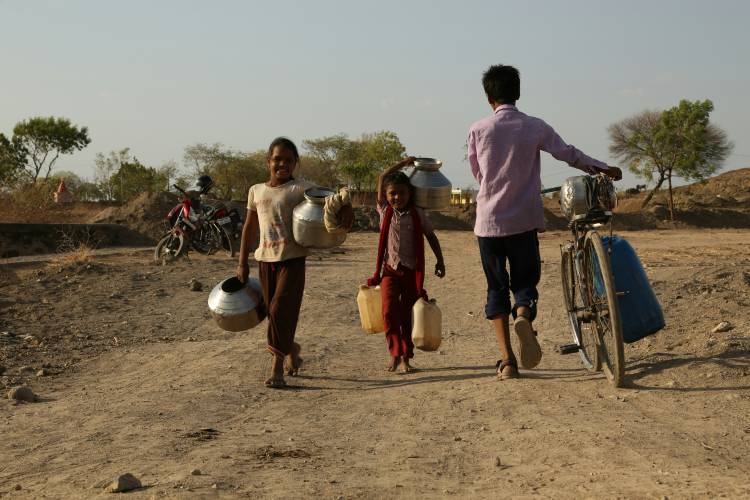India’s escalating water crisis poses a significant threat to the nation’s credit health, says Moody’s Ratings. As the country experiences rapid economic growth, industries continue to consume large quantities of water. Although coal power generators and steel manufacturers bolster economic development, a decrease in water availability could severely impact agricultural production.
India is on the brink of a climate change crisis, worsened by swift urbanisation and industrialisation which are intensifying water scarcity. This could lead to a fall in agricultural output, and to high food inflation and reduced income for businesses and communities. The credit rating agency highlighted that these conditions could exacerbate volatility in India’s economic growth and weaken its resilience to economic shocks. The report serves as a crucial warning, especially as several Indian cities, including Delhi, face severe water shortages.
READ | Wheat price: India juggles stock limits, import duties to check inflation
The looming water crisis
The severity of the water crisis is evident in projections from the Ministry of Water Resources, which indicate that the average annual per capita water availability is expected to decrease to 1,367 cubic meters by 2031, down from 1,486 cubic meters in 2021. The ministry identifies water stress as occurring when availability falls below 1,700 cubic meters per person per year, with severe scarcity occurring below 1,000 cubic meters.
Several factors contribute to India’s water shortage, primarily the country’s reliance on monsoon rains. A 6% shortfall in rainfall in 2023 compared with the average from 1971-2020 led to acute shortages in many areas. The Moody’s report also underscored the role of climate change and extreme weather events in exacerbating the crisis, noting that increased frequency, severity, or duration of these events will further intensify the situation.
Addressing the water crisis
It is imperative for the government and policymakers to urgently invest in water infrastructure and renewable energy to mitigate long-term risks for the sovereign, power generators, and steelmakers, as affirmed by Moody’s. These measures are crucial not only for securing India’s economic stability but also for preventing a humanitarian crisis.
Technological innovation plays a critical role in addressing the water crisis. Advanced water purification and recycling technologies can significantly enhance water efficiency in urban and industrial sectors. India must also foster international cooperation to adopt best practices and technologies that have been successful in other countries facing similar challenges. This can include collaboration on rainwater harvesting, efficient irrigation practices, and satellite monitoring of water resources to predict and manage water distribution more effectively.
Globally, nations are adopting a variety of strategies to combat water scarcity. In Israel, for example, technological advancements in desalination have turned seawater into a reliable water source, significantly alleviating its water crisis. Similarly, Australia has invested heavily in water recycling programs that treat wastewater to safe levels for reuse in agriculture and industry. In Singapore, the ‘NEWater’ initiative has become a cornerstone of its water sustainability, using advanced membrane technologies to purify treated wastewater into potable water. These international examples underscore the importance of innovative approaches to managing water resources sustainably.
Policy reform is another crucial area requiring attention. Strengthening regulations surrounding water usage and management can ensure more sustainable practices across all sectors. Effective enforcement of these policies is just as important as their formulation. This involves not only penalties for non-compliance but also incentives for organisations and communities that demonstrate sustainable water management practices. Policies must be transparent and equitably enforced to ensure widespread adoption and effectiveness.
Despite its potential, the Green Social and Sustainability Bond (GSSS) market in India is still in its early stages, with outstanding bonds totalling only $29 billion, representing a mere 2.2% of the total GSSS bond market in the Asia-Pacific region.
The government has launched various initiatives to combat the crisis, including doubling the budget for the Department of Water Resources, River Development, and Ganga Rejuvenation to $2.52 billion for FY25, up from FY20. The World Bank is also involved, contributing to a national groundwater improvement program with a total investment of $1.35 billion, of which $450 million is committed by the lender.
The transition to green energy, which includes increasing the production of renewable energy, will also help alleviate the water crisis. This shift will reduce the reliance on coal power, which demands significant water use, thereby decreasing the stress caused by the high demand for coal power.
To further conserve water, the government has mandated the use of treated sewage water for plants located near sewage treatment facilities (within 50 km) and implemented zero water discharge and ash water recirculation systems at thermal power plants.
With the global population expected to increase by nearly 2.5 billion by 2050, leading to an estimated 40% rise in water demand, the urgency of addressing water scarcity becomes even more pressing. As 2023 was recorded as the warmest year yet, and 2024 is trending similarly, the frequent news of heatwave-related deaths highlights the dire situation. In a country with a vast socioeconomic divide, the impacts of climate change are felt disproportionately, especially by marginalised communities.
To address these challenges, the government and policymakers must take swift action to ensure the basic right to water access. This includes controlling unplanned urban growth, curtailing over-extraction of groundwater, increasing water reuse efficiency, enhancing community involvement, and preventing the encroachment and degradation of catchment areas.

